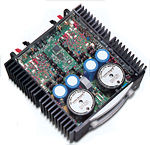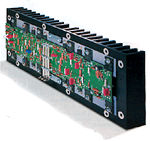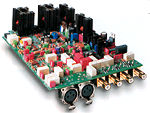| Columns Retired Columns & Blogs |
Mark Levinson No.383 integrated amplifier Page 3
Circuitry and Construction
The No.383's back panel features five analog input pairs, for use with sources single-ended (three pairs of Madrigal-designed RCA inputs) or balanced (two pairs of Swiss-made XLR inputs). The No.383's rear handles protect the interconnect cables if the unit is upended onto its rear panel. All the sockets mount directly to the printed-circuit board (PCB), and inputs are independently buffered. Unselected inputs have their ground connections lifted, eliminating a path by which noise might enter the chassis. All single-ended signals are converted to balanced at the input and remain balanced up to the final current stage. A separately buffered, single-ended record output monitors the selected source. This fixed-level output can be switched off.
The No.383's back panel features five analog input pairs, for use with sources single-ended (three pairs of Madrigal-designed RCA inputs) or balanced (two pairs of Swiss-made XLR inputs). The No.383's rear handles protect the interconnect cables if the unit is upended onto its rear panel. All the sockets mount directly to the printed-circuit board (PCB), and inputs are independently buffered. Unselected inputs have their ground connections lifted, eliminating a path by which noise might enter the chassis. All single-ended signals are converted to balanced at the input and remain balanced up to the final current stage. A separately buffered, single-ended record output monitors the selected source. This fixed-level output can be switched off.
 Four types of control ports give the No.383 many options. There is one 3.5mm mini-jack for an external infrared receiver module if the unit is placed in a cabinet. DC trigger voltage in and out are handled by separate 3.5mm mini-jacks. The 6-pin RJ-11 RS-232 port allows the operating system's software to be updated, and can also be used for external control by a master control system such as an AMX or Crestron. The No.383 supports communications via two 8-pin RJ-45 PHAST-compatible Mark Levinson Link communications ports for two-way communication with a home automation system. This is offered for future integration with PHAST-controlled systems by installing an optional PHAST control board.
Four types of control ports give the No.383 many options. There is one 3.5mm mini-jack for an external infrared receiver module if the unit is placed in a cabinet. DC trigger voltage in and out are handled by separate 3.5mm mini-jacks. The 6-pin RJ-11 RS-232 port allows the operating system's software to be updated, and can also be used for external control by a master control system such as an AMX or Crestron. The No.383 supports communications via two 8-pin RJ-45 PHAST-compatible Mark Levinson Link communications ports for two-way communication with a home automation system. This is offered for future integration with PHAST-controlled systems by installing an optional PHAST control board.
Three power supplies dominate the No.383's circuit board. All communication and control circuits are powered from a separate, low-voltage DC supply with its own transformer—a small, gray block in the front of the chassis. DC regulators are used to provide stable power and to prevent noise generated by the control and communications circuits from finding its way into the audio circuits.
The second and third power supplies are actually two independent DC supplies devoted to the left- and right-channel audio circuits. This duplication ensures that demand from one channel does not modulate the other's power supply. Two large, custom-designed toroidal transformers reduce the AC mains voltage to the ±60V rails. Independent rectification and filtering are followed by active regulation for the voltage-gain and volume-control circuits. High-frequency AC line noise is filtered by common-mode and differential filtering capacitors. Metal-oxide varistors are used for surge and spike protection on the AC line, and prevent excessive inrush current from damaging expensive power-supply components at power-on.
The preamplifier section begins with the gain control. Solid-state stepped attenuators offer precision control of balanced analog signal volume. Local supply regulation and passive bypass components are fine-tuned during the design compensation process to optimize the No.383's sonics during listening tests. Overall gain for the preamplifier section can be adjusted to optimize the volume-control range for loudspeakers of differing voltage sensitivity. Unity gain occurs when the display reads 67dB.
 The No.383's amplifier section employs the same output-stage devices (12 per channel) as are found in Mark Levinson's 300-series dual-mono amplifiers. These bipolar power transistors are packaged in small plastic cases—rather than in the more microphonic-prone metal TO3 cans—and are clamped to the heatsinks with an aluminum bar. The end result is an output stage with low noise, low THD and IMD, and excellent squarewave performance. This stage runs at relatively low temperatures due to the wide spacing of output transistors along the current-gain circuit board and the custom heatsink extrusions mounted on the side of the chassis. Even with its compact chassis, the No.383 delivers 100Wpc at 8 ohms and 200Wpc at 4 ohms continuous, both channels driven, 20Hz-20kHz.
The No.383's amplifier section employs the same output-stage devices (12 per channel) as are found in Mark Levinson's 300-series dual-mono amplifiers. These bipolar power transistors are packaged in small plastic cases—rather than in the more microphonic-prone metal TO3 cans—and are clamped to the heatsinks with an aluminum bar. The end result is an output stage with low noise, low THD and IMD, and excellent squarewave performance. This stage runs at relatively low temperatures due to the wide spacing of output transistors along the current-gain circuit board and the custom heatsink extrusions mounted on the side of the chassis. Even with its compact chassis, the No.383 delivers 100Wpc at 8 ohms and 200Wpc at 4 ohms continuous, both channels driven, 20Hz-20kHz.
Extensive protection from internal and external component failures is provided. Fuses and a mains relay, driven by AC line voltage and frequency-sniffing sensing circuitry, protect the unit from under- and over-voltage conditions. Four sensors mounted on each rail of the left- and right-channel output stages provide thermal protection. Other switches, located inside each transformer housing, disconnect power if the transformer overheats. Soft-clip circuits are used to prevent high-energy, high-frequency ringing artifacts from reaching and damaging loudspeakers. Overdriving the amplifier for long periods or shorting its output switches it off.
 Even with these features, Madrigal's engineers kept the No.383's costs down. As the preamp and power-amp sections don't have to deal with unknown situations, the respective output and input buffers can be eliminated. There is no headphone plug on the front panel, as is sometimes found in other integrated amplifiers. Rather than using exotic materials for the PCB, such as the No.334's avocado-colored cyanate-ester voltage-gain boards, the No.383 uses grade 10 FR-4 glass epoxy PCBs at one eighth the cost.
Even with these features, Madrigal's engineers kept the No.383's costs down. As the preamp and power-amp sections don't have to deal with unknown situations, the respective output and input buffers can be eliminated. There is no headphone plug on the front panel, as is sometimes found in other integrated amplifiers. Rather than using exotic materials for the PCB, such as the No.334's avocado-colored cyanate-ester voltage-gain boards, the No.383 uses grade 10 FR-4 glass epoxy PCBs at one eighth the cost.
Madrigal designed the '383 to be operated only into 8 and 4 ohm loads, not for costly continuous 2 ohm capability. There is no separate Record/Monitor path, and no phono stage. These would have added considerable cost in shielding and advanced low-level circuitry. There is only one pair of propeller-wing speaker binding posts per channel, rather than the dual pairs found on all Mark Levinson power amplifiers. The circuit uses standard components, not cost-no-object Vishay resistors and WonderCaps. This isn't necessarily a bad thing. For example, ML found that inserting a local bypass in the current-to-voltage-converter circuit led to bigger sonic benefits than did the use of an expensive resistor or capacitor.
- Log in or register to post comments




































